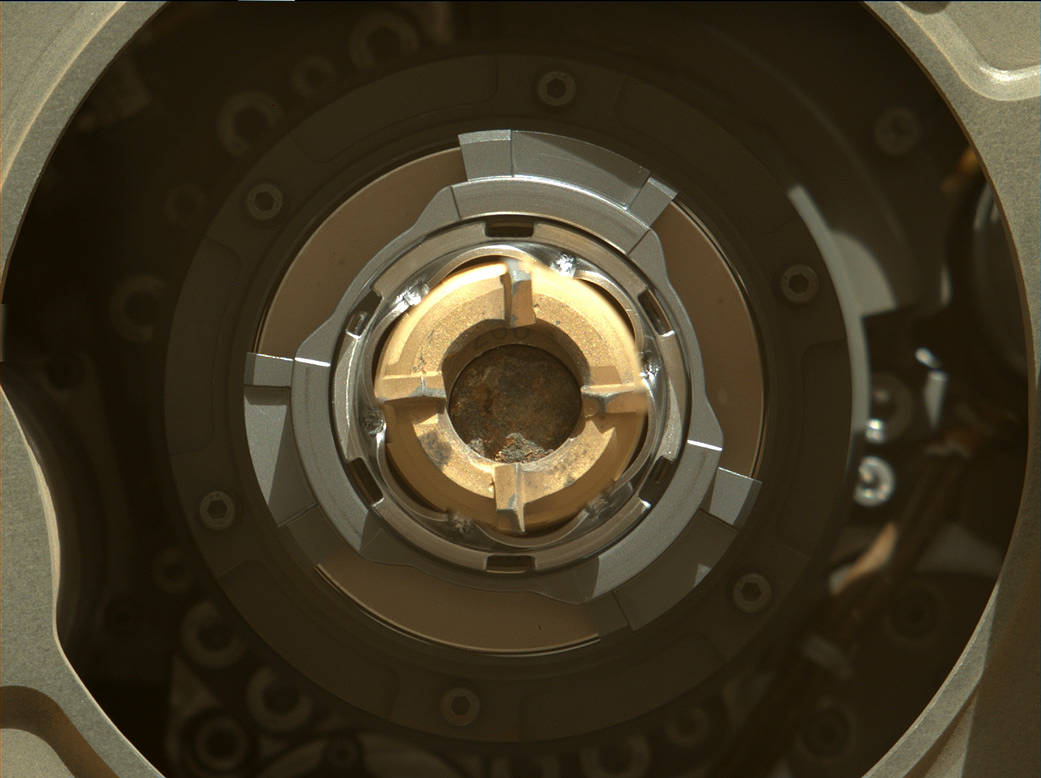This Mastcam-Z image shows a sample of Mars rock inside the sample tube on Sept. 1, 2021 – the 190th sol, or Martian day, of the mission. The image was taken after coring concluded but prior to an operation that vibrates the drill bit and tube to clear the tube’s lip of any residual material.
The bronze-colored outer-ring is the coring bit. The lighter-colored inner-ring is the open end of the sample tube, and inside is a rock core sample slightly thicker than a pencil. A portion of the tube’s serial number – 266 – can be seen on the top side of tube’s wall.
Additional images taken after the arm completed sample acquisition were inconclusive due to poor sunlight conditions. Another round of images with better lighting will be taken before the sample processing continues.
Obtaining additional imagery prior to proceeding with the sealing and storing of Mars rock sample is an extra step the team opted to include based on its experience with the rover’s sampling attempt on Aug. 5. Although the Perseverance mission team is confident that the sample is in the tube, images in optimal lighting conditions will confirm its presence.
A key objective for Perseverance’s mission on Mars is astrobiology, including the search for signs of ancient microbial life. The rover will characterize the planet’s geology and past climate, pave the way for human exploration of the Red Planet, and be the first mission to collect and cache Martian rock and regolith (broken rock and dust).
Subsequent NASA missions, in cooperation with the European Space Agency, would send spacecraft to Mars to collect these sealed samples from the surface and return them to Earth for in-depth analysis.
Image Credit: NASA/JPL-Caltech/ASU/MSSS
这张Mastcam-Z图像显示了2021年9月1日(即任务的第190天或火星日)样本管内的火星岩石样本。这张图片是在岩芯采样工作结束后,在振动钻头和管子以清除管口的任何残留物质的操作之前拍摄。
青铜色外环是岩芯采样钻头。颜色较浅的内环是样品管的开口端,里面是比铅笔略粗的岩芯样品。在管壁的顶部可以看到样品管序列号的一部分——266。
由于光照条件差,机械臂完成样本采集后拍摄的其他图像尚无定论。在继续进行样品处理之前,将拍摄另一轮光线更好的图像。
在进行火星岩石样本的密封和储存之前,获得额外的图像是团队根据8月5日火星车采尝试的经验而选择加入的额外步骤。尽管毅力号任务团队确信样本在管子里,但在最佳照明条件下的图像将确认其存在。
毅力号在火星上的任务的一个关键目标是天体生物学,包括寻找古代微生物生命的迹象。该火星车将描述该星球的地质和过去的气候特征,为人类探索这颗红色星球铺平道路,并成为第一个收集和储存火星岩石和风化层的任务。
随后的NASA任务将与ESA(欧洲航天局)合作,向火星发送航天器,从火星表面收集这些密封样品,并将其送回地球进行深入分析。
了解更多。
影像来源:NASA/JPL-Caltech/ASU/MSSS







